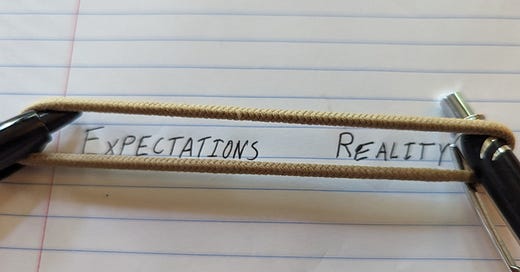The Rubber Band of Expectations vs Reality
When I’ve been at larger companies, I didn’t get much opportunity to see the ways the product I was working on was being used and sold. That changed when I found myself in the same room with the sales folks who were making calls and pitching our product. That closeness led to many course corrections that kept the features being pitched in line with what the product could actually do.
As I talked to more people in product and sales across other companies I found this experience isn’t typical. Misunderstandings or lack of training in a sales group can lead to products being misrepresented. Also when features are promised without communicating with the team building the product the developers will either need to scramble to meet those expectations or customers are left disappointed. This either leads to resentment on the team or resentment by the user, likely both.
The Rubber Band
I like to think of expectations and reality as a rubber band. You can set expectations super high, maybe hit some short term goals but at some point expectations come snapping back to reality. The further apart, the more that snap back to reality will hurt.
I believe this measurement is quantifiable and impacts just about every metric tied to customer satisfaction. Expectations start with an assumption, we can either guide that assumption through marketing, sales, and support or we can meet that assumption by building out what they expect. Doing anything else will just lead to pain (churn) when the user’s expectations collide with reality.
Customer Rubber Bands
Marketing forms the initial set of assumptions we make when we encounter a product. It asks the user to recall a painful experience and invites them to imagine that painful experience solved. How they imagine their particular pain and what they imagine that solution to be is the first place where expectations and reality can start separating.
Someone picking up a sales baton can take shortcuts by promising bigger and better and sooner and further stretching the rubber band. They can also work to bring clarity and realistically tie a user’s pain to the product that exists today. This transparent process also leads to better outcomes because talking in real terms can help identify features that need to be prioritized and built.
Sometimes you just need to build more features to reduce the tension of the rubber band and meet customer expectations. I’ve seen this in software development but it happens just as often through support. When someone calls a support line angry, they have a set of expectations and assumptions, there is very little you can do at that point to change that expectation at that point. However, that expectation can be understood and the tension that has built up in the rubber band can be unwound to create a positive experience as long as there is honesty tied with action. The process of diffusing a tense situation can even lead to the formation of trust.
Job Rubber Bands
This rubber band snapping doesn’t just happen with the products we buy. The excitement that comes with a new job can quickly come crashing back down to reality when a company misrepresents the work. Similarly when people expect a raise or a promotion, the reality of not getting those can lead to them looking for different jobs.
The purpose of an interview and the entire hiring process should be to determine what your organization needs and how far a candidate is from that need. These gaps can stretch the rubber band and education and training can unstretch it. These gaps can be quantified by defining a toolbox of skills that lines up with job requirements.
Life's Rubber Bands
I also like to turn this inward and think about the expectations I have or assumptions I’m making. For me, assumptions may result in anger or anxiety when they don’t align with the results. I ask myself "What can I do to unwind the tension and build a more calm and realistic set of expectations?" More importantly, "what are some of the stretched rubber bands we see built up in others?" and "how can we meet them closer to where they are?"




